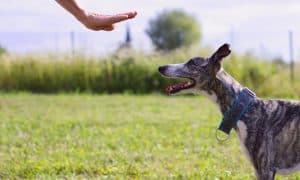“This post contains affiliate links, and I will be compensated if you make a purchase after clicking on my links.”

There are two styles of dog training most popular today. One of the styles focusing on clear communication and teaching the dog the correct thing to do. The other focuses on waiting for the dog to make a mistake so it can be punished.
Being a “pack leader” is a term coined by a nationally televised show about rehabilitating dogs and training people. The “pack leader” is equivalent to the boss, or “alpha.” The rules to this are rather simple, if your dog knows you are the boss, it won’t want to be in charge. But if you are not a strong leader, the dog will sense that and will feel the need to become the “alpha” of the family pack. Basically as long as you show that you are the boss you have nothing to worry about.
Seems like an easy enough concept. Just like any kind of training, consistency is key. This means that every human needs to treat the dog the same way with this style. But what if one of the humans is not capable of winning the confrontations or being physical enough to get their point across? The way this style of training works is if the dog does something inaccurate or inadequate, it receives something aversive, a punishment, e.g. giving a collar “pop” that chokes the dog and jerks its neck. What I dislike most is how confrontational and physical it is. Being confrontational and physical in training can be a recipe for disaster and there is a very good chance that someone will get bitten. The goal with this style of training is that the dog will do the correct thing the next time to avoid the punishment. Really this isn’t a fun way to learn or to teach. Ultimately what you can end up with is a fearful dog that goes through its life walking on eggshells trying to avoid punishment, and a human that is walking right beside the dog acting like a drill sergeant.
Creating partnerships between humans and canines is the style I’ve chosen which I feel is a more effective style of training than being a “pack leader” and using punishment as the primary means of communication. The reason why I like this partnership mentality is because it’s a relationship built off of communication that does not consist of pain or fear. It’s about teaching the dog what it is supposed to be doing.
The philosophy behind partnership training is more along the lines of if the dog is doing something it is not supposed to be doing; it is because it does not know it shouldn’t be doing it. Positive reinforcement is the primary quadrant used with this style. The theory behind this is if you reinforce a dog’s behavior, the behavior is likely to continue and also get stronger. I got into this style of training through trial and error basically. I am what is considered to be a cross over trainer. What this means is I started off training dogs with the “pack leader” mentality and then switched to the “partnership” approach. I have first hand experience of what is more effective, fun, and humane.
One of the main reasons I switched to the positive, partnership style of training was because of how fun it is. I mean, having a dog is supposed to be fun, right?
Another reason I switched to a “partnership” style is because of all the research I did via books, studies online, and working with other professional trainers/behaviorists. All the recent studies are pointing to how much more effective it is to teach things in a positive way. And I can confirm this with my experience doing it both ways.
One of the best parts about training in a positive style is how you get to go about working with severe behavioral issues. There is a myth out there that says severe behavioral issues need to be dealt with a strong hand. I have found this to be very untrue. In fact, typically the more physical you are with a dog, the worse the issue will get. With positive training you focus on modifying the underlying reason for why a dog is acting that way. The majority of the time, to truly fix a behavioral issue, it wouldn’t make for a good 30-minute television show. In fact, when I go into a person’s home to help fix an issue, the last thing I want to do is provoke that unwanted behavior. If my goal is to extinguish the behavior, I’m going to try to use the last time the dog rehearsed the behavior as the starting point for the rehabilitation process.
If you are currently doing things in more of a “pack leader” fashion I encourage you to get curious about positive training. Do some research and see what it’s all about. You may see that you can accomplish things much quicker while having a lot more fun like just like I found.
Kevin Duggan is a Certified Professional Dog Trainer through the Certification Council for Professional Dog Trainers (CCPDT.org) and is a Canine Good Citizen Evaluator through the American Kennel Club. He currently resides in Ohio with his dog, V, a six-year-old Shepherd/Lab mix, where he operates All Dogs Go To Kevin, LLC, specializing in helping build positive relationships between humans and their canine companions using clear communication, not pain and fear. For more training tips and tricks, and to meet his amazing dog, V, follow him on Facebook by clicking here.






















Anyone can find the best of both worlds; clear communication with positive teaching methods, in Amichien Bonding, developed by Jan Fennell in the UK. I urge everyone to look into her work including her book, “The Dog Listener”, as well as the DVD of the same name. It allows people to see dogs as the noble animals they are, and teaches canine communication to assure the dog that there is, indeed, a true leader in the home. This eradicates stress for the dog, because they are given the correct information about their place in the family, all with calm understanding, positive, loving techniques, and complete respect for these wonderful beings with whom we share our lives.
Well if anyone learnt by her mistakes it was Jan Fennell- she made enough . She is not considered a postive+ trainer now days though. kateconnick.com/library/fennelllistener.html
CarolG.
says:I strongly prefer the use of positives but I feel no qualms about making hard eye contact if our dogs are showing initial signs of undesired behavior (e.g. climbing onto a lap to steal food). Once they back off, I immediately relax my expression and praise them. They don’t seem to have become more fearful.
My dog was abused when she was a puppy, we rescued her and she was aggressive with people when they approached fast, but with LOVE and patience we changed that. She is now more friendly (anyway we always watch when people approach her to warn them to be careful and she feels safe) We NEVER EVER punished her, She understands when something is not right and with our tone of voice, firm but not intimidating and never using making physical contact to punish, she understands. When we go for walks, I let her explore and go where she wants to go (but guiding her out of dangerous zones) It is HER walk. She is a lovely and good doggie.
Well said Rosa.
Dixie Tobiaski
says:I use LOVE. I love my dog as a child. I reward with praise and love. When my dog child does not behave, I redirect to something he does positive and praise him again. By not getting attention for his negative behavior he becomes a dog that just wants to please. I strongly do not agree with the pack dog mentality.
A DOG ADVOCATE,
Dixie Tobiaski
dexsmom
says:positive reinforcement would never have cured my dog’s anxiety issues. ever since adapting the “pack leader” style he is a much happier, and sane dog. being a pack leader is not harsh or punitive; it is reassuring to dogs. that is what they respond to.
Mich
says:How do you know? Did you try it?
dexsmom
says:yes, of course I tried it. he was scared of everything…constantly shaking, pacing, would never relax…barked incessantly (well, that’s one thing I’ve never been able to stop and he’ll be 16 in February). no amount of cookies and pets will cure insecurity. once I started adopting the Dog Whisperer techniques, he calmed right down. he doesn’t have to worry cuz he knows I’ve got it covered.
dexsmom
says:and further, pack mentality behaviour does NOT mean punishment or instilling fear. quite the opposite.
Jaimee Gabriel
says:I have been working with “aggressive” dogs, for over 20 years and can attest to the fact that if someone truly understands what being a pack leader means, there is not aggression needed. I do not yell, I do not hit, I do not “Choke” my dogs, or those that I am working with. I DO use a choke chain IN THE CORRECT MANNER. I tell my clients, that the leash and chain are your umbilical chord to your dog. Through that leash you share your emotions, whether that be fear, anger, or confidence. Being Pack leader does not mean DOMINATING, it means being in control of the environment your pack is in. If you are agitated, then your pack will be. If you are calm then your pack will be. I give treats as what they are.. TREATS, just like my snickers bar or ice cream is a treat to me, my pack deserves treats too. My pack is my family, and I am the leader. I set the stage for how they will respond. (FYI, My pack consists of a wolf(3 years Old), a wolf-husky (6 years old), a sheltie/heeler (4 years old), a MUTT (2 years old), and two cats(4 years and 2 years), who play with the wolf. And no, they were not all raised together. lol